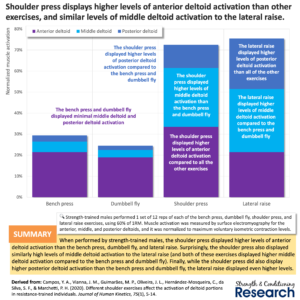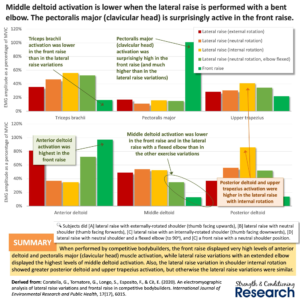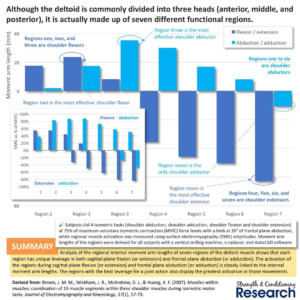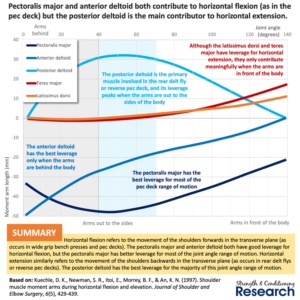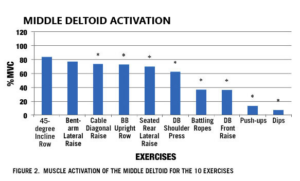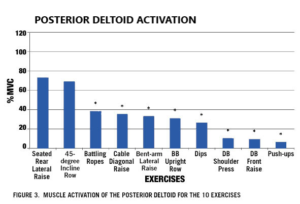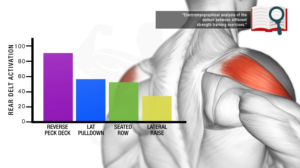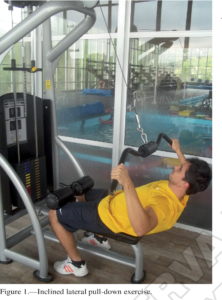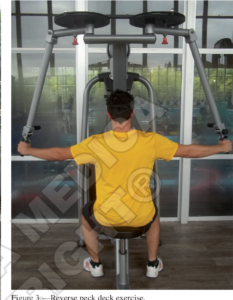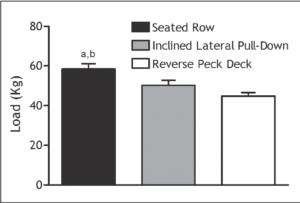DELTOIDS – TRAINING
Click on Image to Enlarge
EMG STUDIES
ANTERIOR, MIDDLE & POSTERIOR DELTOID
– DB Overhead Press, DB Lateral Raise, Low Cable Lateral Raise, Reverse Fly, 45º Incline Row
ACE Research – Top Shoulder Exercises – 2015 – Sweeney – PDF Thesis .
Procedure
– all of the subjects were required to have some weight-lifting experience and attended one mandatory practice session
Exercises
DB Overhead Press
Bent Arm DB Lateral Raise thumbs neutral . Straight Arm Cable Lateral Raise
Seated Rear Lateral Raise – Reverse Fly . 45º Incline Row elbows out
Results
Anterior Deltoid: DB OHP 75% . DB Front Raise 55%
Lateral Deltoid: Incline Row 85% . DB Lateral Raise 80% . Cable Lateral Raise 75% . BB Upright Row 70% . Seated Rev Fly 70% . DB OHP 60%
Posterior Deltoid: Seated Reverse Fly 75% . Incline Row 70%
ANTERIOR, MIDDLE & POSTERIOR DELTOID
– Lateral Raises, Reverse Pec Deck, Incline Lat Pulldown, Seated Machine Row
– Shoulder Press, Bench Press, Pec Deck
EMG of the Deltoid Between Different Strength Training Exercises – 2013 – Botton, Wilhelm, Pinto, Ugjni, Lima
Subjects
– at least six months strength training
Exercises
Smith Machine Shoulder Press; Bench Press; Pec Deck
DB and Cable Crossover Lateral Raises
Seated Row elbows up – seated upright; pronated grip; shoulders abducted to 90°; horizontal shoulder extension
Reverse Pec Deck – neutral grip and elbows straight, performing horizontal shoulder extension
Incline Lat Pull elbows up – posterior tilt position so that the cable of the machine was perpendicular to the body.
Results
Anterior Deltoid: Smith Shoulder Press 70% . Bench Press 55% . Pec Deck 50%
Lateral Deltoid: DB Lateral Raise 55% . Cable Lateral Raise 55% . Reverse Pec Deck 50% . Seated Row 40% . Smith Shoulder Press 25%
Posterior Deltoid: Reverse Pec Deck 90% · Inclined Lat Pulldown 55% · Seated Row 50% . DB Lateral Raises 35% . Cable Lateral Raise 35%
ANTERIOR, MIDDLE & POSTERIOR DELTOID
– Reverse Pec Deck, Incline Lat Pulldown, Seated Machine Row
Analysis of anterior, middle and posterior deltoid activation during single and multijoint exercises – 2015 – Franke, Botton, Rodriques, Pinto, Lima
Procedure
– 12 males with at least one year of strength training experience; MVIC 10RM
Results
Anterior Deltoid: low numbers
Lateral Deltoid: Reverse Pec Deck 50% · Inclined Lat Pulldown 40% · Seated Row 20%
Posterior Deltoid: Reverse Pec Deck 90% · Inclined Lat Pulldown 55% · Seated Row 50%
1










